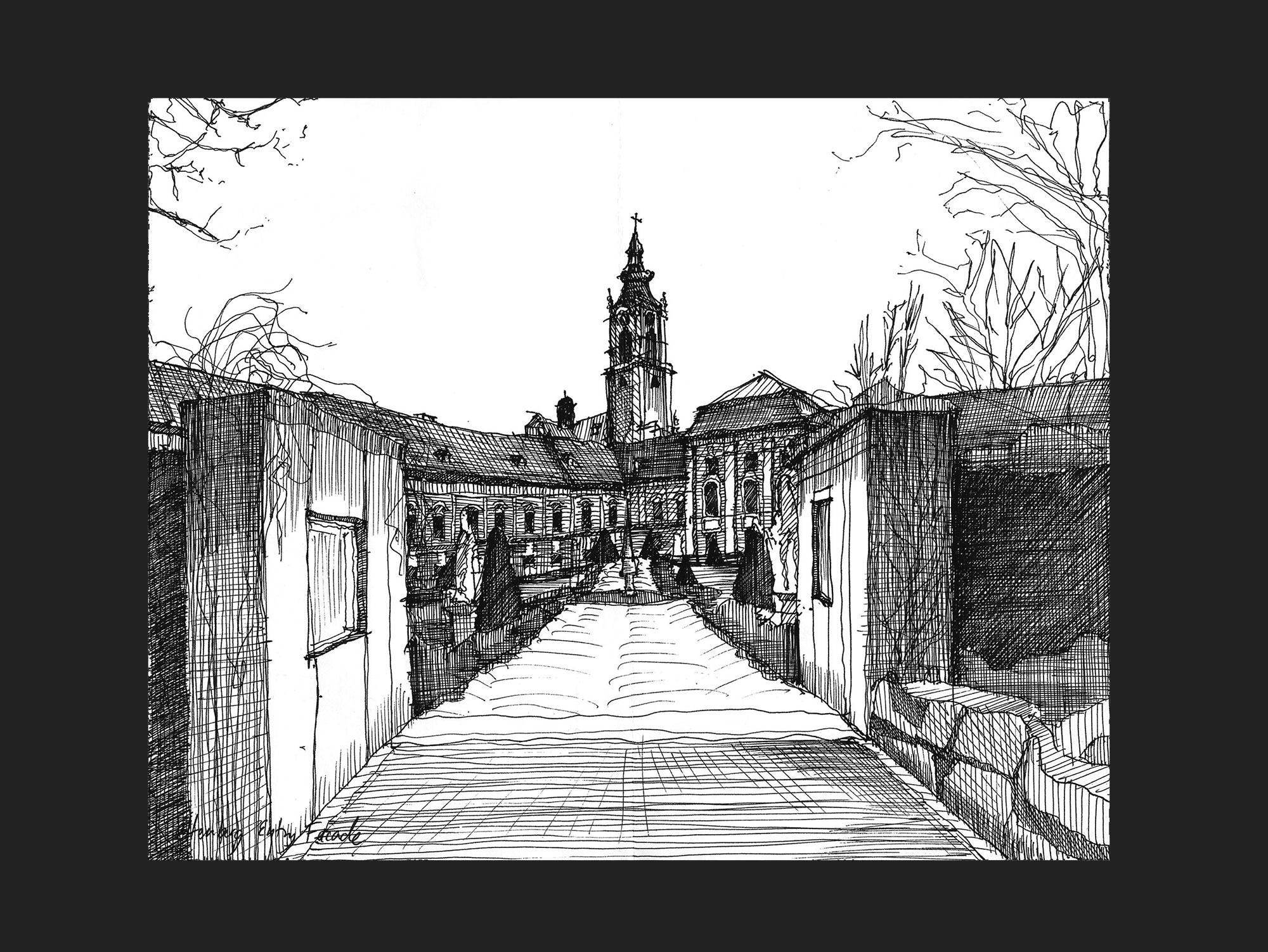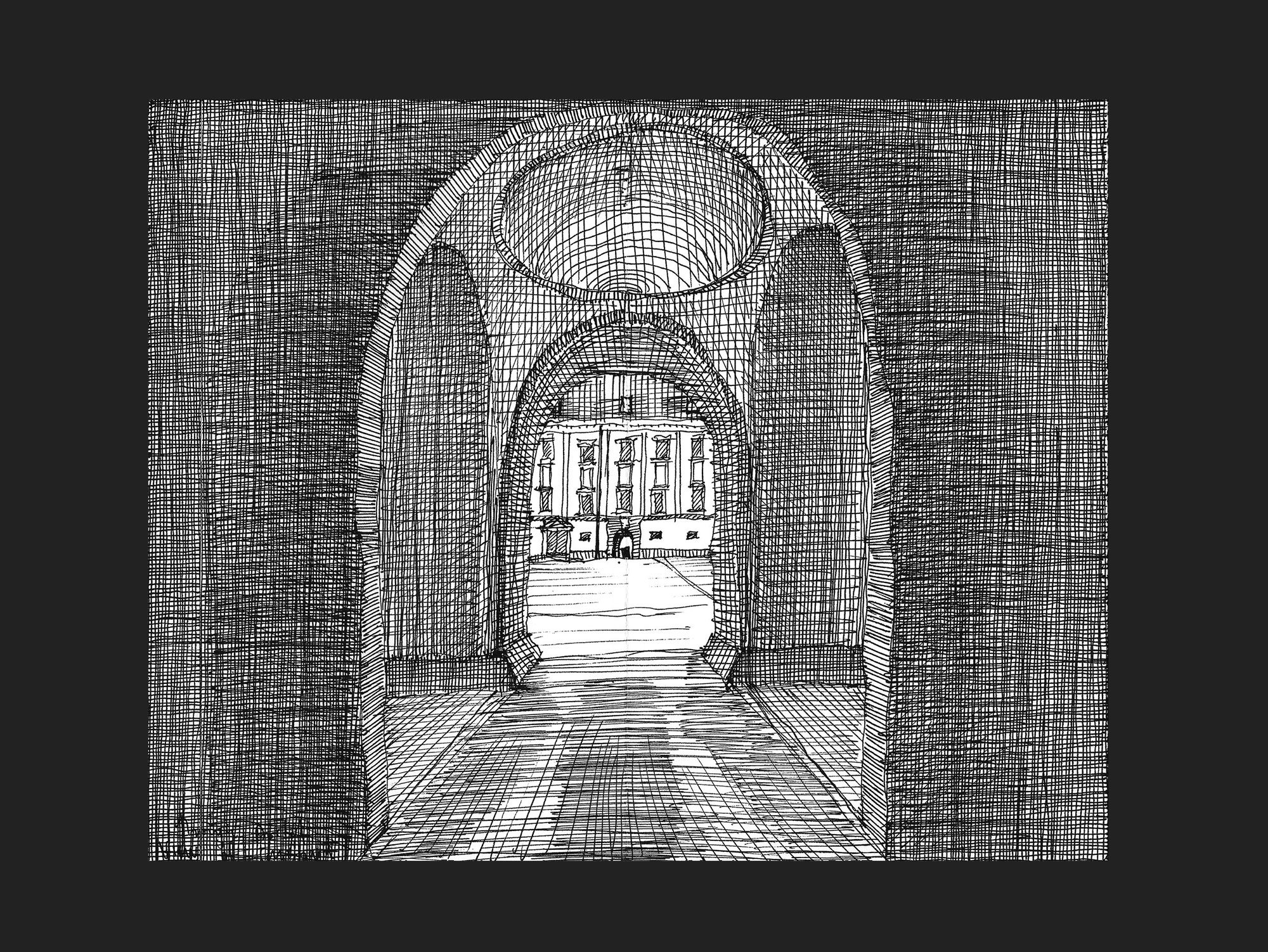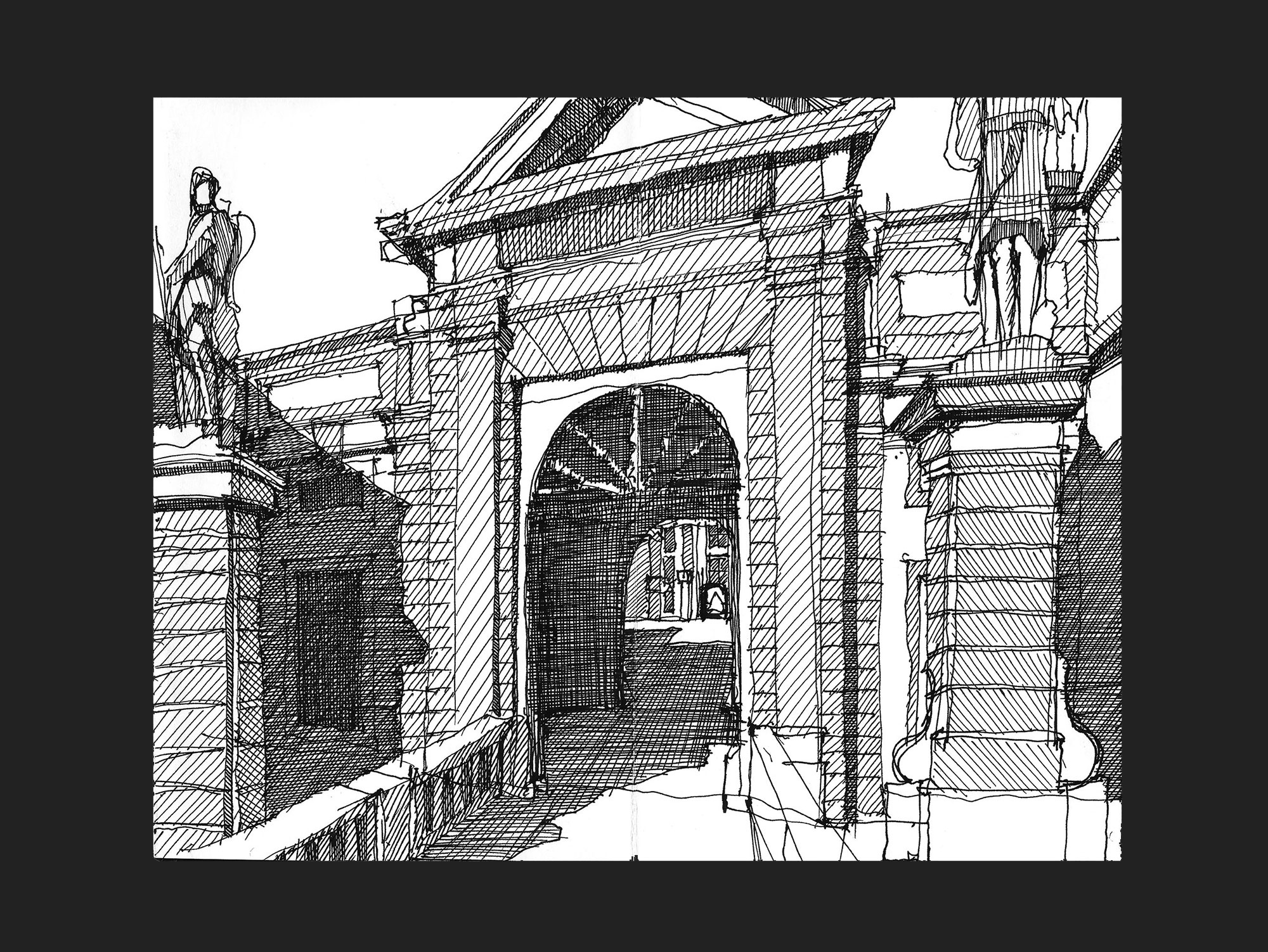Baroque Libraries
The Journey to Getting Lost in a Book
Cornell Univeristy Eidlitz Travel Fellowship (Spring 2017)
Austria, Czech Republic, Italy

Library, St. Florian Monastery, St. Florian Austria
Proposal: to document through perspective drawings the sequences of space into Baroque Monastery Libraries in Czech Republic, Austria, and Italy
Award
Eidlitz Travel Fellowship ︎︎︎
Download
PDF Presentation ︎︎︎
I traveled as an Eidlitz Fellow in search of places that inspire the readers within us. Baroque Monasteries reflect a time centuries ago when the reading room lined with books was a novelty. It was a treasure. They were part of highly choreographed tours through monasteries, incredibly intentional stages for the performance to a visiting dignitary. The dramatic unveiling of such rooms evolved into elaborate transitions from the outside world, be it mountains or dense streetscapes, into the inner sanctuary and back out.
There was an emphasis on the physical journey to prepare oneself for getting lost in a book.
The long hallway that makes us think long while we walk. The open courtyard that proceeds to the dark enclosure, making us aware of our passage.
The relationship to the exterior, the quality of light, the texture, the proportion and scale, and how these things are juxtaposed were careful considerations in Barqoue architecture. By the time we open the book, we are in a state of presence, fully prepared by the place, ready to absorb. Through the following series of leporello notebooks, I sought to capture this experience.
Related Project Pages
Drawings Travel Photography Exhibitions
Drawings Travel Photography Exhibitions
Czech Republic
Prague

Prague is home to two distinct and beautiful Baroque Libraries: The Clementinum embedded in the dense urban center, and Strahov Monastery perched on a hillside at the edge of the city. The Clementinum, famously referenced by Jorge Luis Borges in his short story The Secret Miracle, is a fortified fortress within the urban fabric. After turning off the maze of dense cobblestone streets and passing through an ensconced courtyard, one quickly finds oneself in an inner sanctuary separated from the city itself.
Strahov Monastery, on the other hand, is a long walk from the center of Prague. In what amounts to a cross section from the urban center to the outer edges of the city, the walk across the Charles Bridge and up a dwindling cobblestone street hill slowly induces a sense of tranquility. Strahov is also unique in that there is a pair of libraries making up two sides of an enclosed quadrangle. The Theological Hall reflects earlier baroque styling, and the Philosophical Hall was added later to incorporate the more elaborate high baroque design.




Austria
Vienna, Altenberg, Kremsmunster, St. Florian, Admont, Melk

Further to the west is Admont Abbey, home to largest monastic library collection in the world. Nestled within a picturesque valley surrounded by mountain peaks, Admont is a pared down neoclassical design with simple white facades. The quadrangle is opened up, allowing views of the landscape to flow in. After passing down a long corridor, one enters the massive monastery library where abundant natural light fills the space.
St. Florian Monastery, the largest in upper Austria, is another complete baroque ensemble. After climbing through the hillside town, one passes through the gate, across a dramatic lawn, and through a deep portal into a symmetrical quadrangle. The monastery library, behind the facing facade, features beautiful curved wooden bookshelves. Kremsmunster Abbey and Altenberg Abbey follow similar high baroque organizations of space.
The National Library of Austria in Vienna provides a dignified urban contrast to the numerous rural monasteries. Sited in a historic monastery complex itself, the National Library is part of a dramatic urban ensemble of museums and palaces.












Italy
Rome, Venice, Cesena

The eternal city of Rome hides three Baroque Libraries. The Biblioteca Vallicelliana, located behind the facade of the Oratorio dei Filippini and atop a dramatic staircase, features a muscular, sculptural ceiling designed by Francesco Borromini. The Biblioteca Casanatense is off a street near Santa Maria Sopre Minerva. The expansive hall features a vaulted, clean white ceiling above a dense rhythm of double height bookcases. Finally, is attached to Saint Agostino Church near Piazza Navonna. After climbing up a narrow staircase and walking through a long arched antechamber, the Biblioteca Angelica unveils itself as a immense three story volume with undulating walls of bookshelves.
The Biblioteca Marciana, located on St. Marks Square, takes advantage of an incredibly beautiful urban sequence of space. The inhabitant immerges from the tight and narrow streetscapes of Venice into the vast piazza. This is followed by a dramatic, linear enfilade of rooms proceeding behind the facade of St. Marks Square. It is simulatensouly above and removed from the busy urban piazza while always providing a direct visual connection.
In the civic center of the small Italian city of Cesena, The Biblioteca Malatestiana is unique amongst the libraries I visited. It is one of only two fully intact medieval libraries and the first public library in Europe. There are no bookshelf lined walls with elaborate baroque fittings. Instead, the space is like a church with pew-like benches and desks organized symmetrically about a central aisle, all facing forward. The desks have a selection of a few dozen books; they have metal bindings and are chained to the desks for security, reflecting the incredible value and rarity of books during medieval times.
The Biblioteca Marciana, located on St. Marks Square, takes advantage of an incredibly beautiful urban sequence of space. The inhabitant immerges from the tight and narrow streetscapes of Venice into the vast piazza. This is followed by a dramatic, linear enfilade of rooms proceeding behind the facade of St. Marks Square. It is simulatensouly above and removed from the busy urban piazza while always providing a direct visual connection.
In the civic center of the small Italian city of Cesena, The Biblioteca Malatestiana is unique amongst the libraries I visited. It is one of only two fully intact medieval libraries and the first public library in Europe. There are no bookshelf lined walls with elaborate baroque fittings. Instead, the space is like a church with pew-like benches and desks organized symmetrically about a central aisle, all facing forward. The desks have a selection of a few dozen books; they have metal bindings and are chained to the desks for security, reflecting the incredible value and rarity of books during medieval times.












Complete Notebooks

Notebooks 1-3
1-Front: St. Florian Monstery; 1-Back: Kremsmunster Abbey
2-Front: National Library of Austria; 2-Back: Altenberg Abbey
3 Front & Back: Admont Abbey

Notebooks 4-6
4-Front & Back: Melk Abbey
5-Front: Strahov Monastery; 5-Back: The Clementinum
6-Front: Strahov Monastery Continued; 6-Back: Biblioteca Malatestiana

Notebooks 7-8
7-Front: Biblioteca Vallicelliana; 7-Back: Biblioteca Casanatense and Biblioteca Angelica
8-Front & Back: Biblioteca Marciana

